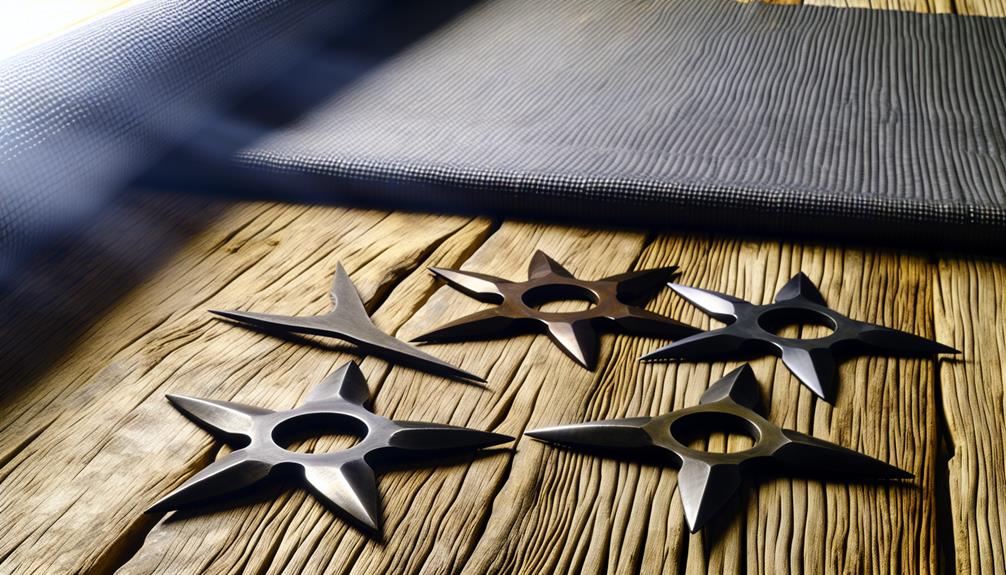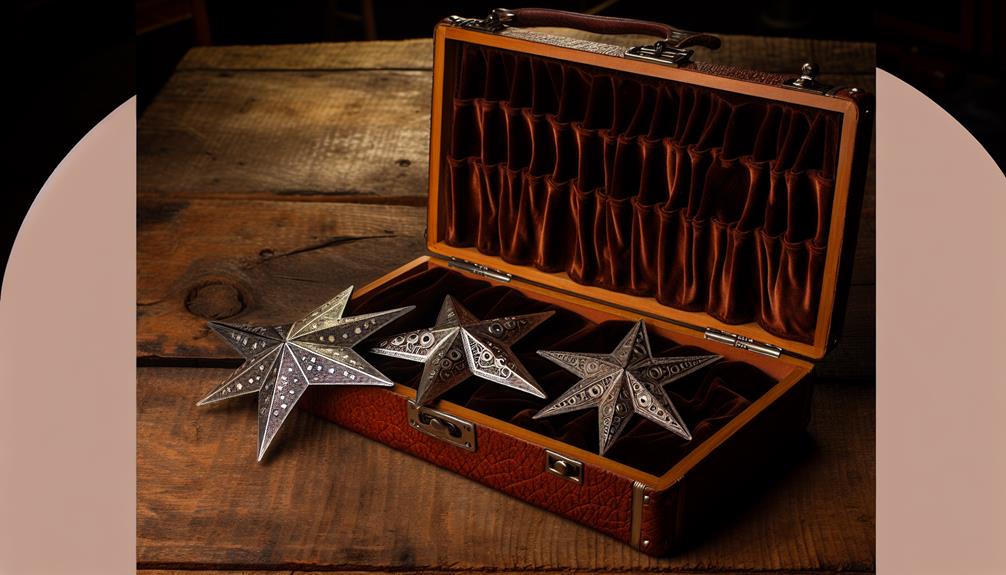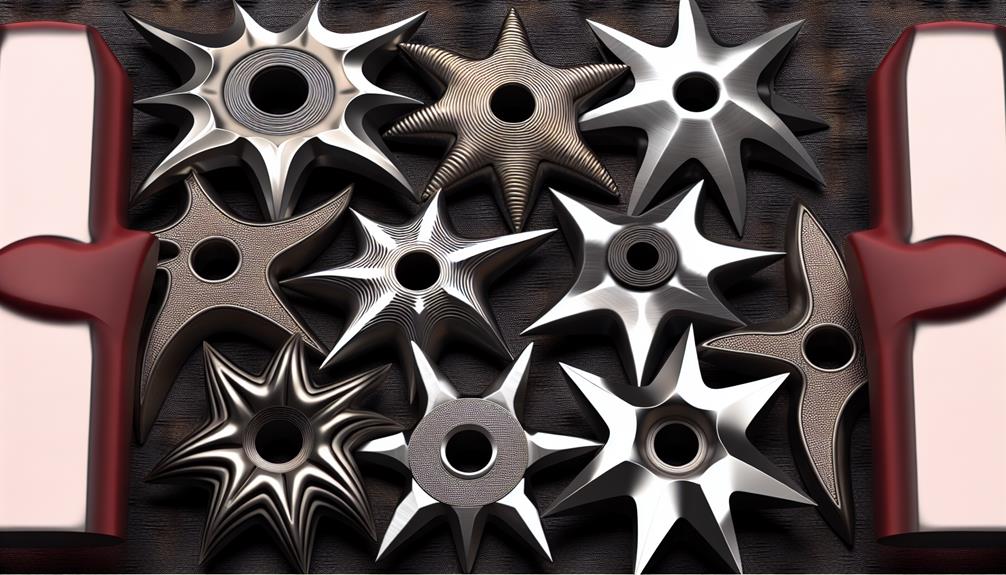
Brainstorm Security Shop

For Orders Over $199

On Any Of Our Products

Details On Refund Page
You’ve likely heard of throwing stars, or shuriken, but have you ever considered their intricate role in both historical warfare and modern martial arts? These tools are not just remnants of a ninja’s arsenal; they embody the blend of artistry and efficiency. Each type, from the piercing bo shuriken to the spinning hira shuriken, serves a unique purpose and requires a specific skill set to master. As you explore the evolution of these fascinating weapons, think about the precision in their design and the discipline required to wield them effectively. What might these ancient skills teach us about modern practices and technologies?
Throwing stars, or shuriken, trace their origins back to feudal Japan, where ninjas used them as stealth weapons. These tools weren’t just weapons; they held profound cultural significance, symbolizing the cunning and stealth of the warriors who wielded them. Over time, their use evolved beyond mere combat implements.
As you delve into their history, you’ll find that shuriken played a pivotal role in the historical evolution of Japanese warfare. Initially, they were simple tools, likely derived from everyday items like nails or broken blades, repurposed by ninjas who excelled in unconventional warfare tactics. This adaptability highlights a period in Japan where resourcefulness could mean the difference between life and death.
The cultural significance of these throwing stars grew as they became embedded in popular lore. They transformed from practical weapons into legendary symbols of ninja prowess, celebrated in countless stories and films. This evolution reflects broader shifts in Japanese martial culture, where the artistry of combat often held as much value as practical effectiveness.
Understanding the history of throwing stars offers you more than insight into ancient weaponry. It reveals a slice of Japanese cultural identity, showcasing a blend of ingenuity, tradition, and myth that continues to captivate people worldwide.
As you explore the world of professional shuriken, you’ll encounter a variety of types, each with unique design features tailored for specific uses.
Delving into these throwing star styles not only reveals their practical applications but also highlights their cultural significance, reflecting centuries of martial tradition and craftsmanship.
Here are some key types you should know:
Understanding these variations enhances your appreciation of their development and specialized uses, making your journey into professional shuriken both fascinating and engaging.
Why do professional shuriken vary so significantly in design? You’ve likely noticed that not all throwing stars look the same, and there’s a good reason for that. Each design tweak serves a unique purpose, tailored to enhance performance and suit specific throwing styles.
First off, let’s talk about aerodynamic features. The shape and weight distribution of a shuriken greatly influence its flight path. You’ll find that some have more points or longer blades, designed to maintain stability in the air and stick better upon impact. It’s all about finding the right balance that works for your throwing technique.
Then there’s the grip design. This mightn’t seem as crucial as the points, but how you hold your shuriken can drastically affect your throw. Some stars feature indented grips, offering your fingers a natural place to sit, which helps in achieving a consistent release. Others might’ve a smoother edge to allow for a swift, clean throw without friction.
Mastering these elements ensures your throwing star isn’t just a piece of metal but a refined tool that complements your skills.
Mastering a few fundamental techniques can significantly enhance your accuracy and effectiveness with throwing stars.
It’s crucial to understand not just how to hold or throw a star, but also how to mentally and physically prepare for each attempt.
Here’s how you can improve:
Beyond just the physical act, consider your training drills and how they mimic competition strategies.
Analyzing your performance post-practice or during competitions can give you insights into what adjustments are necessary for improvement.

To enhance your precision and accuracy, you’ll need to start with choosing the right equipment that suits your style and strength.
Mastering various throwing techniques is essential, as it helps you understand the mechanics and dynamics of each throw.
Lastly, by enhancing your target practice sessions, you can consistently improve your accuracy and control under different conditions.
When choosing the right equipment for your training in precision and accuracy, it’s essential to consider both the weight and balance of the throwing stars.
Selecting the ideal throwing star involves understanding how different materials and designs can impact your performance.
Throwing star materials vary widely, each offering unique benefits. Stainless steel stars are durable and maintain their shape, while lighter materials like aluminum can provide a quicker release.
Ergonomic designs are also crucial; they ensure the star fits comfortably in your hand, enhancing your control and reducing the risk of injury.
Here are some key points to keep in mind:
You’ll find that the right combination of these elements greatly enhances your throwing precision.
Remember, the goal isn’t just to hit the target, but to do so consistently and effectively.
Choose wisely to maximize your potential in the art of throwing stars.
Once you’ve chosen the right throwing stars, it’s time to hone your throwing techniques to achieve precision and accuracy. Mastering the art starts with understanding the fundamentals of throwing mechanics. You’ll need to focus on how you align your body, the way you balance your weight, and the motion you use to release the star.
It’s all about the fluidity and control of your movement.
Next, let’s talk about grip techniques. The way you hold your throwing star significantly affects your throw. You might prefer the pinch grip, where you hold the star between your thumb and forefinger, or the modified hammer grip, which involves wrapping your fingers around the star for more stability.
Experiment with different grips to see what feels most natural and offers the best control.
Why not take your skills to the next level by enhancing your target practice sessions? Training for precision and accuracy isn’t just about throwing more; it’s about throwing smarter.
Integrating advanced targeting strategies and structured practice routines can dramatically improve your accuracy and consistency with throwing stars.
Firstly, let’s talk about setting up your practice space. You’ll want a variety of targets at different distances and heights to mimic real-life scenarios. This variety challenges your skill and keeps the practice engaging.
Here’s how you can make the most out of every session:
Always prioritize your safety and that of others while handling professional throwing stars. Here’s a breakdown of essential safety measures and guidelines that’ll help you manage risks and ensure a safe environment.
First, you need to invest in the right safety gear. Protective eyewear and gloves are a must to prevent any accidental injuries. It’s not just about wearing them; you must ensure they’re up to standard and well-maintained.
Understanding and implementing risk management strategies is crucial. This involves setting clear training protocols and supervision requirements. Don’t practice alone; always have a supervisor or a trained professional overseeing the sessions.
Emergency procedures should be well-known and easily accessible to everyone in the training area. Quick response to accidents can drastically reduce the severity of injuries.
Lastly, pay attention to environmental considerations. Ensure the practice area is suitable and free of unnecessary hazards that could pose risks during training sessions.
Here’s a quick reference table for you:
| Category | Key Points |
|---|---|
| Safety Gear | Protective eyewear, gloves |
| Risk Management | Supervision, clear protocols |
| Emergency Procedures | Accessible first aid, trained responders |
| Training Protocols | Structured, supervised sessions |
| Environmental Considerations | Hazard-free area, adequate space |
As you select your professional throwing stars, it’s crucial to consider the material and durability, as these factors directly impact their lifespan and performance.
You’ll also need to evaluate the weight and balance to ensure precision and ease of handling.
When selecting professional throwing stars, you need to consider both the material and durability to ensure top performance and longevity. Different material types offer unique advantages, and choosing the right one can significantly affect your throwing experience.
Here’s what you should focus on:
Understanding these aspects will help you choose throwing stars that not only meet your aesthetic design preferences but also align with your performance needs and user preferences.
How do weight and balance impact your ability to handle throwing stars effectively? Well, mastering the art of throwing stars isn’t just about technique; it’s also about choosing the right equipment. You’ve got to consider the aerodynamic properties and weight distribution of each star to ensure you’re using one that complements your style and strength.
If a star is too light, it won’t travel far or fast enough, reducing your accuracy and impact. On the other hand, a star that’s too heavy might be difficult to throw with precision, especially if you’re aiming for speed or a specific target.
The balance point of the star, where the weight is evenly distributed, plays a crucial role as well. A well-balanced star rotates smoothly through the air, maintaining a stable trajectory and increasing the likelihood of hitting the target.
You’ll find that the perfect balance can significantly enhance your throwing technique. When a star feels right in your hand, and the weight is distributed in a way that aligns with your throwing motion, you’ll throw with greater confidence and precision.
Choosing the right throwing star involves more than just picking a sharp-looking design; functionality plays a key role in your success. When you’re selecting your equipment, it’s crucial to consider how each piece reflects both cultural significance and artistic expression, alongside its practical use.
Here are some key points to keep in mind:

Throwing stars, traditionally known as shuriken, have found a unique niche in modern competitive sports. As you delve into this arena, you’ll discover that competitive throwing events aren’t only about skill but also about adhering to strict guidelines.
These events are governed by comprehensive throwing star regulations that ensure fairness and safety for all participants. You must familiarize yourself with these rules, which dictate everything from the permissible weight and design of the shuriken to the techniques allowed during competition.
At these events, precision and control are paramount. Competitors are tasked with hitting target zones from various distances, and points are awarded based on accuracy. The atmosphere is intense, as each participant meticulously calculates their throw, aiming to garner maximum points.
It’s a thrilling spectacle, blending ancient martial arts with modern competitive dynamics. If you’re considering entering this field, start by attending local competitions to observe these rules in action.
Understanding the regulatory environment is essential, not just for compliance but to strategically enhance your performance. Competitive throwing isn’t just about physical prowess; it’s a test of patience, precision, and profound respect for the sport’s traditional roots.
As you look toward the future of shurikenjutsu, emerging technologies and evolving techniques are set to redefine this traditional martial art.
The cultural significance of shurikenjutsu continues to influence its modern adaptations, ensuring that it remains a respected and vital part of martial arts heritage.
You’ll find that the integration of digital tools and virtual reality into training programs isn’t just a possibility; it’s becoming a reality.
Here are some key trends you should watch out for:
These innovations not only preserve the essence of shurikenjutsu but also make it more accessible to a global audience.
You’re witnessing a fascinating phase where tradition meets technology, creating a dynamic future for this age-old art.
Keep an eye on these developments; they’re bound to enrich your practice and understanding of shurikenjutsu.
Yes, you can use throwing stars as a form of meditation by focusing on your throwing techniques and mental focus.
It requires you to be fully present and mindful of every movement, which can help clear your mind and reduce stress.
You might be wondering about the legality of owning throwing stars.
Well, it varies widely depending on where you live. Many places have specific ownership restrictions because they’re considered weapons.
You’ll need to check your local laws to see if you can legally possess them. It’s not just about whether you can have them at home; it also affects if you can carry them around.
Always better to be safe and informed!
If you’re looking to buy high-quality throwing stars, you’ll find that prices can vary based on the materials used and the brands.
Typically, you might spend anywhere from $20 to $100 or more. The cost depends on whether you opt for traditional steel stars or those made from modern, high-tech materials.
Popular brands tend to charge a premium due to their reputation for durability and precision in manufacturing.
When looking into how environmentally sustainable manufacturing is, you’ll find it varies.
Many companies now focus on using sustainable materials and eco-friendly practices to reduce their carbon footprint. They’re incorporating recycling initiatives and seeking ways to make production cleaner.
If you’re concerned about the environment, it’s worth researching brands that prioritize sustainability. This approach not only helps the planet but also appeals to consumers who value eco-conscious products.
As a professional thrower, you’ll likely follow a specialized diet and fitness regimen tailored to enhance your performance.
This includes high-protein meals to build muscle and carbohydrates for energy, crucial for mastering throwing techniques and enduring long training sessions.
Your regimen also involves regular use of training equipment to improve strength and precision.
Staying hydrated and maintaining a balanced diet are key to keeping your body in top condition for every competition.
As you delve into the world of professional throwing stars, you’re embracing a legacy steeped in history and skill. Whether you’re refining your technique or choosing the ideal shuriken, remember safety is paramount. Keep honing your precision and engaging with the community to push the boundaries of this ancient art. The future of shurikenjutsu is bright, fueled by tradition and innovation—your journey is just beginning, and it’s as sharp and thrilling as the stars you throw.
